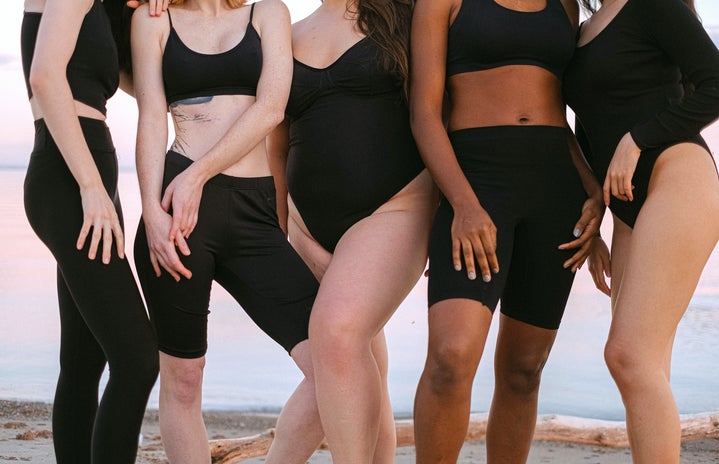According to the Golden Ratio of Beauty Phi- a scientific measure of physical perfection, the likes of Jodie Comer and Bella Hadid being consistently regarded as the most beautiful women in the world this year, as often, has genuinely made me question the fickle concept of beauty. However, my main point of discussion today isn’t the subjectivity that comes with beauty, but rather the objectiveness that is attached to it.
What’s deemed as beautiful and desirable has always been fleeting, whether it’s directly within the beauty industry or within pop culture. However, what I find interesting is how beauty trends seem to be an amalgamation of features from minority ethnic cultures. Although the concept of beauty is subjective and very much ‘in the eyes of the beholder’, both by Western standards and in accordance with the Golden Ratio, women deemed to be objectively beautiful are either White or display Eurocentric features. This notion of white women being the objective standard of desirability is also displayed through the acclaim and praises that rise when they sport otherwise deemed as ‘imperfect’ atypical ethnic features. This brazen pattern shows that minority features are only replicated when it’s convenient but are never viewed as ‘perfect’ enough to become the standard.
A way in which the changing nature of beauty ideals has been highlighted is through cosmetic surgery trends. Plastic surgery has been a common phenomenon for decades, initially holding a purely medical function, then transpiring into a symbol of wealth and status as only the affluent could afford to alter their appearance in such a permanent- and in some cases even invasive- form. Whether plastic surgery is predominately regarded as a form of healthcare or a beauty practice is greatly dependent on one’s geo-political location, but generally speaking, plastic surgery today is typically associated with aesthetic enhancement. However, with the introduction of payment plans to accommodate the lower classes (pioneered by Ivo Pitanguy), or through illegal and unsafe practices to reduce surgical costs, cosmetic surgery has become more accessible to the masses through the years.
The shifts in popularity surrounding the desired procedure to undergo can be attributed to the influence of celebrity culture which transpires through the media, with celebrities and influencers contributing towards minimising the stigma around cosmetic surgery in the West over the past decade. Although breast augmentations remain the most common form of plastic surgery, accounting for 15.8% of all procedures, the demand for buttock lifts (also known as Brazilian Butt Lifts/BBLs) has risen by an astonishing 77.6% since 2015, signifying the change in beauty practices. Relatedly, Vogue controversially proclaiming ‘the era of the big booty’ in 2014, evidences the subjectivity of desirability, with this statement commencing an epoch where the stereotypical black frame was suddenly widely sought after within mainstream society – a stark contrast to the beliefs held in the noughties and prior, where a ‘big booty’ was seen as repulsive.
This integration and biased praise of Afro-Caribbean beauty norms into wider society, while said features still remain negatively received on the owners, displays the ostracization of ‘blackness’ within the mainstream until and unless there’s an advantage it can bring. The advantages can take multiple forms such as monetisation through the commodification of the black body, or some type of cultural capital- either in wider society or directly within the black community. Despite the aestheticization of black features, black women being the individuals that don’t quite mirror the orthodox beauty standard, are left susceptible to harm due their natural appearance. They are already vulnerable as women due to the perception of their biological femininity, but this is exacerbated due to their race, highlighted through the hyper-sexualization and fetishization of the black female body. Although women’s bodies are constantly subject to objectification and thus potential harm, the concepts of race and female embodiment are interconnected, forming false expectations concerning the sexualisation of black females. This, moreover, illustrates how black women are not deemed as enough to be viewed as inherently beautiful, but merely sexual objects.
Although the new-found romanticisation of the BBL physique has arguably been endorsed by fast fashion (aided by its mass consumption) and influential figures, this seemingly widespread agenda to move away from a slimmer build does not mean that the distinct big bust, invisible waistline, and large bottom frame has automatically become the objective standard. Skinny has always been ‘in’, remaining the constant norm, and while ethnic features are purely blueprints for short-lived trends, it remains undeniable that the objective beauty standard lies within the hands of the white male and their desires.
The political privilege and power of the white male strongly influences much of what is currently observed in society, having built the foundations for the exaltation of ‘whiteness’ and anything in proximity to resemble it. This is therefore why in accordance with the Golden Ratio metric of ‘beauty’, those that are celebrated as objectively attractive are either white or minority-ethnic women of lighter complexions with stereotypical Caucasian features. Perceptions of beauty, and thus the benchmark of ‘perfection’, in the West only portray and reinforce the false notion of the superiority of Western features, which permeates into other cultures through the overall influence of the white patriarch.
While it can be said that Western beauty trends are merely objective attempts to claim practices and features within minority cultures, these can never break beyond the status of a trend and become everlasting standards due to the embedded norm of whiteness, which has been fixed as the ultimate form of attractiveness- ‘perfection’ – by the white man.
Written by: Michele Ngue-Awane
Edited by: Harsheni Maniarasan


